EBS Marketeer
Introduction
Technical Outline
Benefits
Purpose
Where It Fits In
Marketing vs Sales
Contacts
Targeting
Communication
Packaged project
Source Code
User Manual
Executables

An integrated database and communications software package for direct marketing and sales applications. After developing it as a personal project, I went on to sell this package commercially from 1985 to 1994 and continued customer support until 1998. I still run this original MSDOS version in a PC emulator called DOSBox on Linux. Click on the image for a full size view.
Download Marketeer's executables and sample data by clicking on the link called "Executables" at the bottom of the list of navigation links on the left. Place the downloaded '.zip' file in your 'home' directory. Unzip the zip file. A new directory [folder] called 'ebs_marketeer' will appear in your 'home' directory. This now contains all the necessary executables and data files for running Marketeer. However, DOS programs like Marketeer won't run directly on modern operating systems. You need to install a DOS emulator environment. The one I use is an Open Source offering called DOSBox. To install DOSBox on Ubuntu Linux, open a terminal and enter the command: [NOTE: my own terminal prompts prefix these commands]
rob@neddy:~$ sudo apt-get install dosbox
The prefix "sudo" for root user and the name of the command for installing from the distributor's repository may be slightly different in other distributions. DOSBox is now installed on your computer so you don't need to do the above command again the next time you want to run Marketeer. Once loaded, enter the command:
rob@neddy:~$ dosbox
The DOSBox window will open. You can now minimise the terminal window to get it out of the way, but don't close it. In the DOSBox window you will see the Z: prompt. Now mount DOSBox's C: drive at the directory 'ebs_marketeer' where you placed the downloaded Marketeer files. Then change to the C; drive and start Marketeer. Do this by entering these 3 commands in sequence:
Z:\> mount C: /home/[your name]/ebs_marketeer
Drive C is mounted as local directory /home/[your name]/ebs_marketeer/
Z:\> C:
C:\> mktr.bat
Marketeer's initial screen should appear in the DOSBox window. Enter the password "password". You should now be in Marketeer's main menu as illustrated above. You can now use Marketeer alongside the following introduction and also while reading the User Manual.
Marketeer is a well specified contacts management database package comprising 57,509 lines if BASIC code, which I developed during the early eighties. It includes a 400-page fully indexed on-board user manual. I marketed, sold and supported this package personally, which gained for me many satisfied customers. I also trained the staff at its user sites explaining its purpose and where it fits within an organisation. In so doing I showed how the strict separation of the marketing function from the sales function can be advantageous within both 'supported' and 'multi-role' sales teams. Marketeer is made up of:
As an aid to implementing Marketeer at user sites, I later designed, developed and produced a formal packaged project based on a generic planning chart + questionnaires.
Since Marketeer was first launched in 1981, other software producers have jumped on the sales and marketing bandwagon. Of the confusing rash of sales and marketing packages which have entered the market of late, most seem to have pre-sale visual appeal and demonstrability as their prime design brief. Marketeer's design brief always has been and shall remain pure post-sale mission performance. Marketeer is aimed at those who wish to take a calculated approach to improving the efficiency, effectiveness and cost-benefit of their sales/marketing function. It is not for those who are impulsively impressed by dazzling visuality. In 1992, Marketeer was operational at 20 sites in the UK with a combined total of 150 users.
From 1980 to 1990, I spent 15,000 hours developing a Marketing and Sales aid called 'Marketeer'. This was released first on an ITT 2020 (Apple II clone) in 1981. It was converted for the IBM PC/XT during 1985, and a multi-user network version was installed at its first user site in June 1986. It is a growing design which is continually being improved in the light of in-house research and suggestions from the field. It is currently being re-written as a Java applet to run within a browser window or on a Java-enabled operating system's desktop. An overview of Marketeer's main functions and their interactions is shown below:
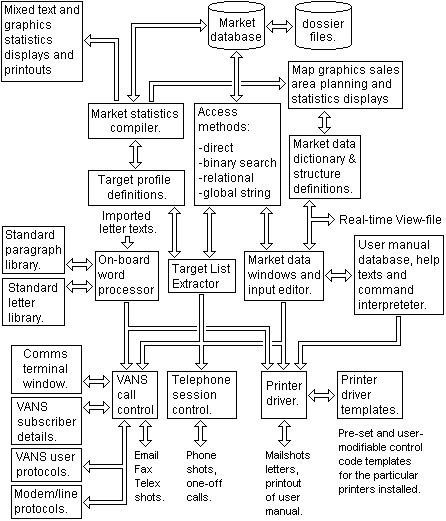
Marketeer provides the user with automated help to:
The database maintains four types of information on contacts within a company's market place:
In order to meet the needs of marketing and sales people receiving incoming calls, an achieved design requirement was to be able to retrieve any customer record by any access route within 1½ seconds (including the time required for searching, loading, decrypting and displaying) with at least 15,000 records on the database.
Entry, retrieval and maintenance of individual records is done through the Market Data Windows. In addition to normal indexed access, a cross-reference indexing facility is included, which allows the user to link individual contacts' records into chained groups. A chained group may consist of contacts who have a given type of relationship between themselves as opposed to their individual relationships with the user company.
A hot-key facility is provided to swap the display back and forth between the Market Data Windows and a context-controlled on-line user manual window to provide easy self-tutoring for new users. This is in addition to context-controlled help texts. The manual can be printed out at any time in whole or in part. It is updated by diskette along with the software.
A viewing window is also provided which can pipe information in real-time from a file maintained dynamically by another package. This is useful for allowing sellers of fast-moving stock to see up-to-the-second stock levels so stock does not become committed to more than one customer.
Marketeer's targeting facility allows the user to specify the market profile (in terms of characteristics and attributes) of a subgroup of individuals or companies within his marketplace, and then extract from the main database a shortlist of the individuals and companies who fit this market profile. These 'target' profiles can define a wide variety of group-types. For example, a target profile can specify such groups as:
or various combinations of these.
Having extracted such a shortlist, the user may view the records of those on the list and cull out any individuals he specifically wishes to exclude. The members of a targeted shortlist can be presented in alphabetic order, postcode order, reference order, or various combinations of these. Any targeted shortlist can then be compiled as:
for use by those respective subsystems.
Marketeer provides the user with several means of communicating with his market or customer base as follows:
Marketeer contains an on-board word processor specially designed for writing sales and marketing letters. It provides a means of creating and maintaining a library of standard paragraphs. It also provides a means of creating and maintaining a separate letter library. Letters can either be written from scratch, or started off by copying in selected standard paragraphs which can then be tailored and added to within the new letter. A variant of a standard letter can be produced by a duplication-and-edit feature which preserves the original letter.
The text of a letter is independent of its means of transmittal, so the decision as to whether it should be sent by post, Email, telex or fax can be taken after it has been written. In fact, it could be sent by post and repeated to the same or another addressee by fax, telex or Email later. Letters to be sent by post can be typeset fully justified for printing in a proportional space typeface. Any finished letter text can be selected from the letter library as the current text to be use by the mail and communications subsystems for printing or transmission.
The mailing subsystem can print one-off letters addressed to any contact retrieved individually from the market database, or an entire mailshot based on the currently selected letter text and the currently designated target list. Style of salutation and signing is determined automatically from information within each addressee's market database record. Full monitoring and control of a mailshot print run is maintained with facilities and procedures built in for coping with paper jams and temporary loss of printer access.
The mailing subsystem automatically 'ticks off' each addressee as his letter is printed, and updates his database event key and diary entry with the fact that this particular letter has been sent to him. A mailshot report can be printed once the mailshot has been completed. This gives a skeleton letter showing the letter text followed by a list of addressees to whom the letter was sent.
Different types of printer can be used by Marketeer. This is made possible by a single printer driver which can be controlled by a printer control code template. Templates are provided for various printers, but the user may edit these to make use of added printer facilities as technology progresses.
Marketeer uses two logical printers which may be the same physical printer if necessary. One logical printer is a draft quality printer for reports, and the other is a correspondence quality printer for printing letters. Modern printers such as the Hewlett-Packard DeskJet can fulfil both roles well, although in high throughput installations a separate matrix printer and laser printer would be preferable.
The electronic mail, telex, fax subsystem is simply an electronic version of the mailing subsystem, except that the messages are produced in a 'telex or memo' style or format. A value-added network service [VANS] such as Mercury Link7500 is used as a store and forward facility so that operative's time is not wasted by busy subscriber terminals, and so that Marketeer can send the text to the type of terminal (Email, telex, fax, etc.) specified in the individual addressee's market database record.
It also means that multi-users can send messages independently of each other using only their normal telephone extension lines: no need for individual telex or fax lines, or the necessary pre-segregation of recipient terminal types required by a server-based telex or fax dispatcher. Subscription and protocol details for several VANS can be maintained so subscribers to different VANS can be contacted.
A terminal window is attached to the communications subsystem which can be used to send letter texts manually, receive incoming messages and capture them in an incoming messages library for later viewing or printing, or to allow a marketing or sales operative to check out the credit worthiness of a new customer or prospect via one of the VAN services such as Infocheck.
Marketeer's telephone subsystem can be used in two ways:
The market database can be used as a super telephone directory that reads the called customer's telephone number directly from his on-screen name & address 'card' and dials it automatically.
The currently-selected target list can be used to retrieve customer records in list-order, auto-dialling each customer in turn on command.
Both update each called customer's market database record with the fact that a telephone call event took place and the date on which it was made. Before, during or after a call, the user is free to enter or amend the customer's name & address, telephone number, market profile, diary notes and dossier file.
The following relates to the second use — the telephone session. After each call attempt has been made the user must select a 'call result' option as a measure of how useful the call was. Any call which failed is presented to the user again once the end of the list has been reached so that it can be re-tried as many times as is expedient.
A telephone session may be broken at any time and continued later. At the end of a session when all calls that can be made have been made, a telephone session report can be printed giving the name and company of each called contact together with the time, date and result of each call. A summary of the numbers of calls with each possible outcome or result is given for session evaluation.
On multi-user installations, a facility is provided to allow one user to expedite a telephone session on behalf of another — e.g. for a telesales operative to phone on behalf of a rep who is currently on the road. The auto-dialling software maintains full control of the call, providing visual indication of digits being dialled, and prompting the user upon dialling completion.
Customer market profiles are stored in the database as binary selections. These are interpreted for presentation through a data dictionary as plain English names or descriptions. The plain English names and descriptions are placed in the Data Dictionary when Marketeer is installed and are updated infrequently, and even then only on management instruction.
When assigning a named or descriptive classification within the market profile of a specific individual contact or company, the user simply selects one (or more according to the nature of the key) of the name/description choices offered for that key. This minimises the wrong or non-categorisation of an individual or company due to the mis-keying of an indexed name or description.
Free-form textual descriptions can be entered elsewhere in an individual's or company's market database record.
Marketeer's geographic key is based on the U.K. Postcode System. Sales areas are defined as the post areas they contain. Users define or plan their sales areas on a Postcode Key map by marking them on the map. (A plastic laminated map is preferred for this purpose.) The two-letter post area codes are then placed in the data dictionary along with suitable sales area names. Provided each individual's or company's address is postcoded, their sales area is determined automatically by the software, and is automatically re-determined if sales areas are subsequently changed without any need to alter individual or company market database records. A sample sales area scheme based on the IBA television transmission areas is supplied with Marketeer.
The user-defined sales areas can be displayed on a map of the U.K. (with an expanded inset of London) from which the user can check that the postcodes have been entered correctly. Incorrect post area assignments appear as disconnected fragments of sales areas in parts of the country where they should not be (although fragmented sales areas are perfectly valid if that is what is required). On the map graphics display is also provided a bar graph showing the percentage of all the people and companies on the market database who are located in each sales area. A bar showing the percentage of the U.K. 'population' (postal delivery addresses) in the same sales area is also displayed for comparison.
Marketeer has a market database statistics compiler which counts the numbers of individuals and companies in the database holding each setting of each key within the market profile structure. It can perform the counts either on the database as a whole, or on only those individuals or companies who are members of a specific target group. These counts can then be presented as either tabular displays or as graphics bar charts. They may also be printed.
Marketeer includes functions which import and export customer data into and out of its database. Export can be selective in that what is exported is a targeted list.
Although they are continually improving, PC networks have not been completely fault-free since Marketeer was first implemented on a network in 1986. Network errors can be caused by such things as power supplies and people accidentally tripping over signal cables and disconnecting them. If a network error occurs at certain critical times it can corrupt a database. Marketeer has a built-in function for reconstructing its database in such an event from 'redundant' or replicated data within its database. To date, this facility has never failed to regain full database integrity after a database corruption. A quicker facility is included simply for checking the integrity of the database if an event has occurred which could possibly have resulted in database corruption.
All customer/prospect information within the market database and dossier files is encrypted. This ensures that information cannot be obtained from the database by reading its files directly via a byte-picker of a word processor with an ASCII-literal view option.
One copy of the Marketeer software can support up to 40 users (or up to 100 by special installation). Each unified Marketeer database can hold up to 32767 customer records. One copy of the software can drive an unlimited number of independent databases subject to hard disk capacity.
Below is a typical equipment configuration for Marketeer in a marketing/sales office with 5 telemarketing/sales secretaries supporting 10 sales reps around the country. The Marketeer software and database are held on the server and marketing/sales data is accessed and maintained by the sales secretaries from their individual PCs connected to the local area network (LAN).

| Mar 1981 | Design and development of Marketeer started. | |
|---|---|---|
| Aug 1984 | Version 1: original version released on ITT2020 / Apple II | |
| Nov 1985 | Version 2: redesigned and expanded version on IBM PC XT | |
| Mar 1986 | Version 3: improved in the light of market feed-back. | |
| Sep 1987 | Version 4: first Novell network version on a customer site. | |
| Apr 1994 | Version 5: enhanced functionality from market feedback. |
| by reference number: | ~ 1 second | |
|---|---|---|
| by alphabetic/geographic indexes: | < 2 seconds |
Benchmarked on a PS/2 30-286 with 15,000 records on database. Same or better times achieved by 286 terminal on 10Mb/s network. Times include seek, load, decrypt and display.
Storage Required:
| Executable & fixed data files + user manual: | 2.9 MB | |
|---|---|---|
| Contact (customer/client) records: | 1.25 Kb each |
A more detailed Technical Outline is available.
Reactive Marketing: To most people, the term marketing invokes notions of creating a corporate identity, designing stationery and literature, organising seminars and exhibitions, designing and placing advertisements and other strictly passive attempts to communicate with the market. If marketing goes no further then the only way contact with a new client can be established is if the client takes the initiative and responds to a message aimed not at him personally, but at the market in general.
Proactive Marketing: But if and when a client does respond — and also to reach those who do not — another complementary form of marketing must be used — a form which follows on from and builds upon the foundation of passive or conventional marketing. It is this complementary proactive form of marketing — that of deliberately seeking out and making contact with new prospective clients individually — which Marketeer addresses.
A Comparison: A useful analogy for comparing reactive and proactive marketing is to think of conventional or reactive marketing as broadcasting and proactive marketing as two-way point-to-point communication. Marketeer is a tool to help you communicate point-to-point with individuals within both your established and prospective markets.
Marketeer's Role: Marketeer was created to help PR, marketing and sales people to search out and build strong commercial relationships directly and individually with all relevant people within both established and prospective client organisations so that those relationships become channels of information, credibility and confidence through which business and sales will easily and naturally flow.
Marketeer generally assists with three major functions:
PUBLIC RELATIONS: building your organisation's name and corporate image directly and personally within the minds of precision-targeted decision makers and market influencers.
MARKETING: promoting your products and services directly to targeted decision makers and influencers by the same means.
SELLING: the public relations and marketing aspects of the selling cycle.

Don't Focus Inward: Most business software addresses what is happening inside your business. Indeed even most so-called sales and marketing software grew out of — is an extension to — sales order processing, accounting and credit control systems which deal with a business's internal activities of taking orders and supplying customers. They originated from such scenarios as "Since our credit control system sends letters to customers, why don't we extend its use to sending sales and prospecting letters also?"
Don't Focus Outward: At the other extreme are the pan-galactic market databases provided by list vendors which focus solely on the market without reference to any particular user business. They contain global information for general consumption about the market not your market.
Focus on Relationships: Marketeer is neither of these. Neither did its design stem from either of them. Marketeer's focus is on the relationship between your business and its market, between you and your client, between your salesperson and your client organisation's power base. Its task may be seen as that of situating itself as it were 'behind' your market and hitting it with a big hammer to make sales orders come shooting out into the lap of your sales order takers.
A Demarcatable Role: Marketeer's role is thus separate and easily demarcatable from that of other areas of business software. It can therefore be implemented separately from other applications while retaining the capability of integrating with them.
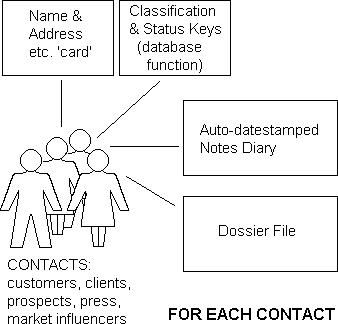
For each of your contacts Marketeer provides you with:
a name and address 'card' on which to record their name and address, telephone number, fax or telex number, company name, job title and any little memory-jogger notes,
a Classification and status box in which to record, in terms of your own classification system, how they fit into your marketplace, what last took place between you (e.g. a phone call, letter, meeting ... ) and when it took place, and what your next planned action is with regard to them,
an action and notes diary which is automatically date-stamped by the system in which to record one or two lines of notes regarding your last conversation with them and what should happen next,
a dossier file which is in effect a word processor file coupled to the client record in which you can type whatever you want to about that contact such as company details, sales history, your contact's likes and dislikes, interests and hobbies, significant events and so on.
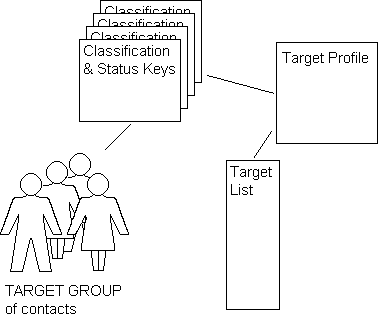
Target Profiles: Marketing activities are most effective when you target your efforts at those among your contacts who are most likely to be interested in the particular product, service, offer or event you are dealing with at the moment. You tell Marketeer the 'market profile' of Mr & Mrs Ideal Contact by setting up a Target Profile which specifies exactly which classifications they fit.
List Extraction: Marketeer then scans your database seeing whose Classification & Status settings fit the Target Profile you specified, and puts them on a 'shortlist' which we call the Target List.
Standard Profiles: You can set up a number of Target Profiles on Marketeer — for instance, you can have one for all your press contacts, one for all the consultants and advisors you need to keep informed about your products, and one for each of the groups of contacts who form the various sectors of your market for the different types of products and services you offer. And you can reserve one to adapt as and when for inviting the right people to your current seminar etc..
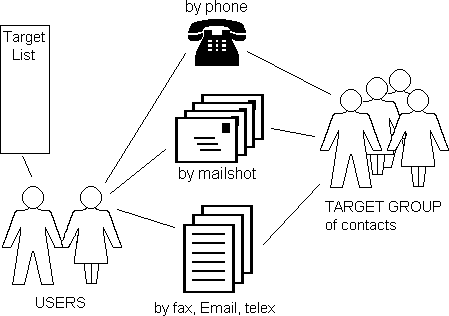
Apart from being able instantly to retrieve the details of and communicate with any individual contact, Marketeer provides the means for you to contact target groups of people in organised sessions. So, from the currently selected target list, you can:
telephone each contact on the current Target List and update their details while talking to them (Marketeer will automatically dial them from the number on their name and address card.)
prepare a group letter and mail it to everyone on the Target List
send the same letter as a fax, telex or electronic mail message
Marketeer produces an automatic report on your telephone session or mail, telex, fax or Email shot.
Public relations & marketing on the one hand, and sales on the other, are two quite separate corporate functions. Though a single human representative usually fulfils both roles in the field, he will be inevitably better supported in these two readily demarcatable areas by separately implemented systems.
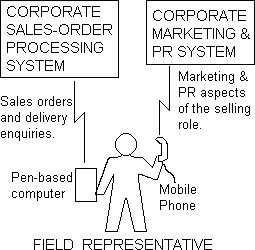
The modern field representative has to be much more than just a sales order taker. He must represent his company completely to the customer. His full role therefore must comprise:
A Public Relations role of building and maintaining his company's image
A marketing role of building and maintaining the visibility of its products
The role of taking and managing the fulfilment of sales orders
What so many systems designers fail to realise is that in systems terms, the first two are unrelated to the third. The only common element between them is human. The same single human being ends up doing all three jobs simply for economy in that the places he goes are those where one must be in order to do each of these jobs, namely in front of the customer.
There is just one other point at which the first two functions touch base with the third and that is again across a human interface because what passes between needs to be filtered and shaped by human value-judgement and interpretation. It is the point where sales history is used as one of the inputs for the planning of future public relations, marketing and sales strategies.
From a systems viewpoint the first two functions are completely demarcatable and solvable separately from the third. Marketeer is a packaged solution to the first two with over 15,000 hours of research and development behind it. And we know where to source state-of-the-art solutions to the third.

The sales manager plans sales operations and enters the criteria for generating salesmen's calling schedules.
The sales secretary looks after two or three salesmen in the field. Generates daily or weekly calling schedule for each salesman. Uses schedule to brief and direct salesman regarding his next call. Does telephone sessions for appointment-making.
Salesman calls on customer and takes written or voice memo notes as necessary. Reports outcome of call to sales secretary over car phone and receives briefing and directions regarding the next call. Sales secretary updates the database according to salesman's phone report.
Sales manager views status of any customer or group of customers on-line.
Advantages:
No technology training of salesmen. It is assumed they know how to talk and how to use a car phone. Only one PC per three field salesmen required.
Corporate sales and marketing data is secure. No transmissions along open communications lines. No laptops lying on car seats or in car boots asking to be nicked along with all the sensitive customer information they contain.
One sales secretary frees 3 salesmen of the administrative chores they don't like so that they can do more of what they do best — talk and sell.
Disadvantage:
The salesmen lose their latest status craze — the laptop. They will have to be content with a car and cellphone.
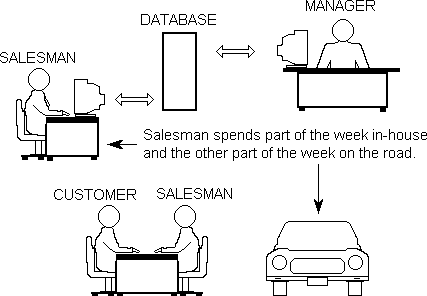
The sales manager plans sales operations and enters the criteria for generating salesmen's calling schedules.
Salesman works in-house for part of the week to update the system with details of the calls he made last week and to generate his own calling schedule for this week. Uses schedule to conduct telephone session for general PR and for appointment-making.
Salesman calls on customer according to his schedule and takes written or voice memo notes with which to update the system when he is next in-house.
Sales manager views at will the status of any customer or group of customers.
Advantages:
The salesman's total control of his own actions with technology taking the strain out of administrative chores makes for a high level of job satisfaction.
One PC should suffice for two to three salesmen.
Corporate sales and marketing data is secure. No transmissions along open communications lines. No laptops lying on car seats or in car boots asking to be nicked along with all the sensitive customer information they contain.
Disadvantage:
On many occasions the sale and installation of Marketeer is simply a matter of mailing the diskettes and loading instructions to the customer. However, in other cases, the customer is a small niche-market firm with only a handful of long standing customers and no established marketing function. Seeing its vulnerability in a rapidly globalising market, it wants to widen its customer base. In this case a whole marketing operation has to be planned and set up within the firm. This is the function of Project Marketeer.
The project has two phases. An Analytical Phase first creates four foundational reports:
This is followed by an Implementation Phase during which the content of the reports is realised as a working proactive marketing operation.
The project is planned by mapping the specific requirements of a given customer on a skeleton project chart. This is then used to manage the project for its duration. On this chart, time runs vertically downwards. Each task of the project is represented by a short vertical line between two sausage shaped date fields containing the task's start end dates. On the right of the line is a small circle showing how many days the task should take. This circle is also a hyper-link to the task's engineering and administrative documentation. There is also a square showing how many people are allocated to the task. This is also a hyper-link to the project's human resources documentation. These show who the people are and what part each plays in the task team. Where tasks are in parallel, the critical one at any given time is emphasised automatically in colour. Not all the paths shown on the skeleton chart are present for every project.